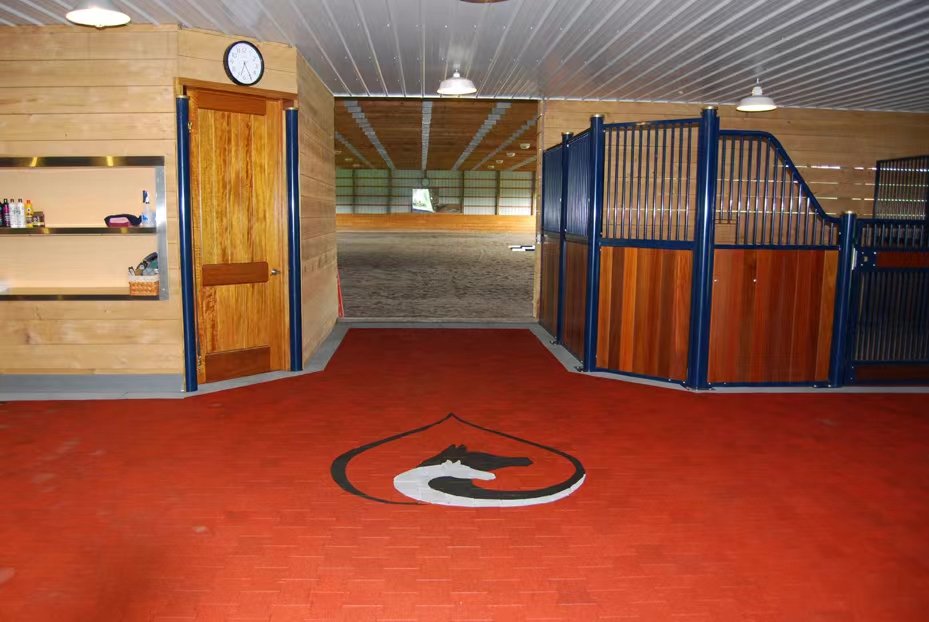
Caring for horses requires attention to detail, dedication, and an understanding of their environment. Among the essentials in a stable is the horse stall mat—a significant investment that provides comfort to our equine friends and plays a pivotal role in maintaining hygiene.
Over time, these mats can accumulate dirt, manure, and moisture, leading to unpleasant odors and potential health risks for the horse. Moreover, an improperly maintained mat can become a breeding ground for harmful bacteria.
So, how do you ensure these mats remain clean, smell-free, and serve their purpose in the long run? In this comprehensive guide, we aim to answer this pressing question and many more related to horse stall upkeep. From power washing techniques and odor elimination to selecting disinfectants and understanding the adaptability of these mats for other uses—like in-home gyms—we dive deep into making your stable maintenance journey more manageable and efficient.
Can You Power Wash Horse Stall Mats?
Given their robust nature and frequent exposure to dirt and grime, horse stall mats often prompt the question: is power washing a viable cleaning method?
The simple answer is yes, but it’s essential to understand the advantages and precautions associated with this cleaning technique.
Benefits of Power Washing:
1. Deep Cleaning: Power washing provides a more thorough cleaning than regular hose washing. The high-pressure water effectively removes embedded dirt, grime, and even minor stains that might be challenging to eliminate otherwise.
2. Time Efficiency: Compared to scrubbing by hand or using a regular hose, power washing can significantly reduce the cleaning time, making the task more manageable, especially for more extensive stables.
3. Elimination of Bacteria: The force from power washing not only removes visible dirt but can also help reduce harmful bacteria that might have accumulated on the mat surface.
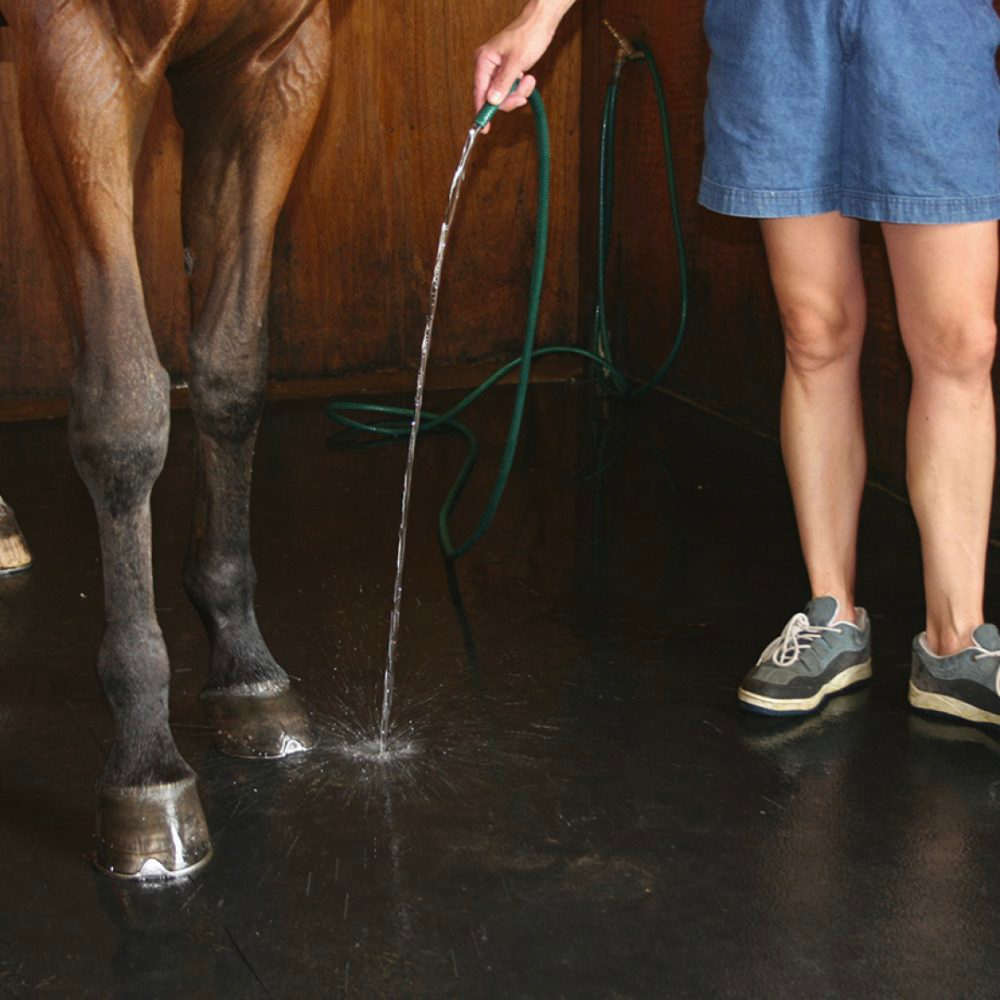
Precautions and Things to Avoid:
1. Avoid Too High Pressure: While power washing is effective, using extremely high pressure can damage the rubber surface of the mats or cause them to erode over time. It’s essential to find a balance that cleans without causing harm.
2. Water Temperature: Using cold to lukewarm water is recommended. Hot water can damage the integrity of rubber mats or cause them to warp.
3. Drying: Ensure the mats are adequately dried after power washing. This can be done by laying them out in the sun or using a leaf blower. Remember, trapped moisture beneath the mats can lead to mold growth or degrade the stable’s flooring.
4. Cleaning Solutions: If you use a cleaning solution with your power washer, ensure it’s safe for rubber mats and non-toxic to horses. Always rinse thoroughly to ensure no residue remains.
In conclusion, while power washing can be a tremendous asset in maintaining the cleanliness and longevity of horse stall mats, it’s crucial to approach the task with knowledge and care to ensure the safety and comfort of our equine companions.
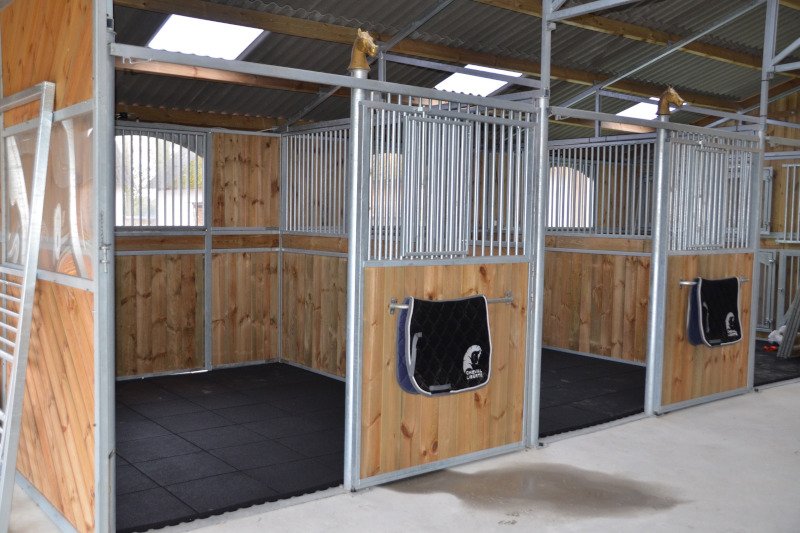
What's the Best Strategy for Odor Removal from Horse Stall Mats?
Every barn owner and horse enthusiast knows that a horse’s stall is more than just a room for the animal; it’s their sanctuary. However, ensuring the cleanliness and freshness of rubber horse stall mats can sometimes feel time-consuming, especially with the constant threat of wet and soiled bedding.
Nonetheless, cleaning horse stall mats can become a smoother, less daunting job with the right tools and strategies. Here are some helpful tips:
Embracing Natural Cleaning Agents:
1. White Vinegar: White vinegar is not just a kitchen staple; white vinegar can be a champion in stall cleaning. A mixture of white vinegar and warm water sprayed on the stall floor helps neutralize odors. After allowing it to sit for around 15 minutes, you can sweep away the mixture, leaving the mat smelling fresher.
2. Baking Soda: Similar to its action in our home gym shoes, baking soda works wonders on horse stall mats. Spread a generous layer on the mat and let it sit overnight. This absorbs the stench and makes your horse’s stall more inviting. In the morning, use a manure fork or sweep it off.

Commercial Solutions:
Several gym mat deodorizers, designed originally for gym equipment in garage gyms, are equally effective for cleaning stalls. An absorbent deodorizer, for instance, can be spread across the mat to absorb moisture and release a pleasant aroma.
Regular Maintenance: The Key to a Happier Horse:
1. Routine Checks: Make it a habit to inspect for wet spots or signs of dirty bedding regularly. Using a manure fork, remove manure daily and replace soiled bedding with fresh shavings.
2. Deep Cleaning: Every few weeks, empty the stall, lift the rubber mats, and clean underneath. Whether it’s a concrete floor or another material, cleaning beneath ensures no trapped moisture, which can lead to mold.
3. Air It Out: On a sunny day, take the mats outside. Letting them air dry not only eliminates odors but also disinfects them.
4. Attention to Detail: Remember the nooks and crannies. The stall door, wall, and even water buckets should be cleaned regularly to ensure the entire stall stays fresh.
5. Moisture Control: Ensure mats are completely dry after cleaning. Wet bedding or a damp floor can be a hotbed for bacterial growth.
Incorporating these methods into your regular cleaning routine ensures that cleaning horse stall mats sounds simple and is effective. Remember, a clean stall is more than just about hygiene; it contributes to the well-being and happiness of your equine friend.
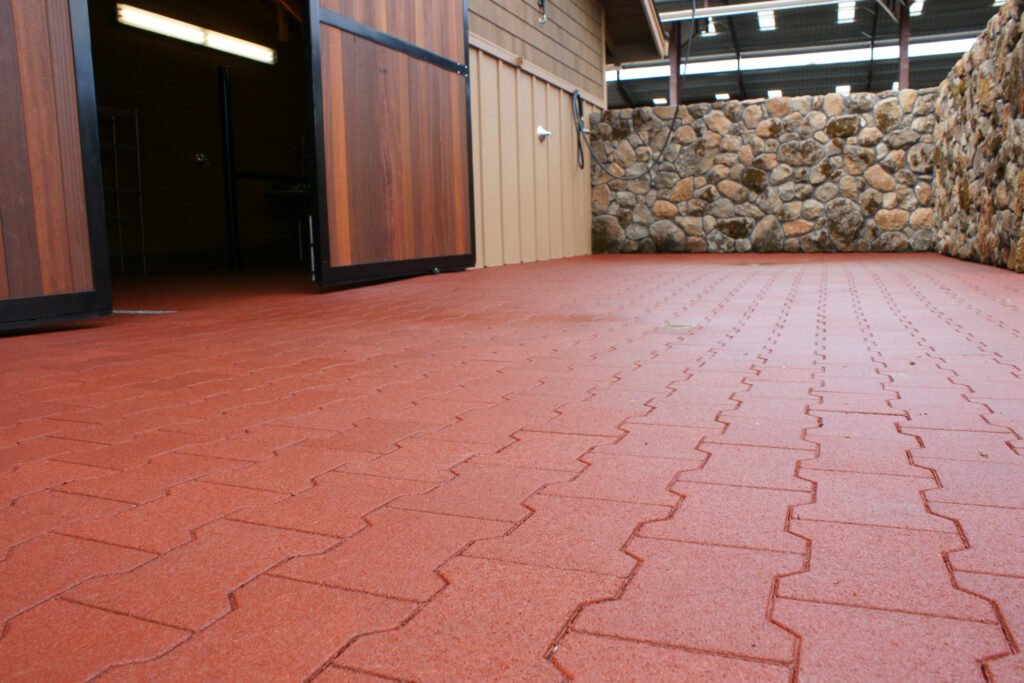
What Determines the Frequency of Cleaning Horse Stall Mats?
Cleaning horse stall mats is much like maintaining the floor of a garage gym. Just as gym-goers prefer a clean surface, horses deserve a spotless and hygienic stall floor. The frequency of cleaning isn’t just about adhering to a strict schedule but also understanding the dynamics of the stall.
Factors to Consider
1. Horse’s Habits: Each horse is unique, and their habits can significantly influence how often you clean a horse stall. If a horse tends to create a bigger manure pile or frequently spills water, the mats may need more regular attention.
2. Stall Environment: Just like how a garage gym’s environment can affect its cleanliness, the condition of horse stalls plays a considerable role. If moisture gets trapped often, causing wet spots, it may signal the need for frequent cleaning.

Indicators Your Stall Mats Need Attention
1. Odor and Wetness: A lingering odor or a persistently damp mat’s top layer clearly signals cleaning time. Make the job easier by emptying the stall and using dish soap and warm water to scrub off stains. Using a sponge mop can help in reaching those tricky corners.
2. Visible Dirt and Residue: If the remaining shavings are soiled or there’s a clear dirt buildup, it’s an obvious sign. Employ a muck bucket and a wheelbarrow to clear out the debris efficiently.
3. The Horse’s Discomfort: If the horse avoids specific stall sections or seems restless, it might be due to an unclean mat. This is especially true if there’s a wet spot or an accumulation from manure piles.
4. Using Effective Cleaning Agents: Beyond just using dish soap, consider pine sol for a deeper clean. It not only helps in breaking down dirt but also leaves a pleasant scent. However, ensure you rinse thoroughly to avoid any residue, as dirty water left behind can become a problem in itself.
In wrapping up, the key to maintaining clean bedding and ensuring the well-being of your horse lies in being observant. Regularly monitoring the state of stall floors, understanding your horse’s habits, and being proactive in cleaning can go a long way in creating a healthy environment for your equine companion.
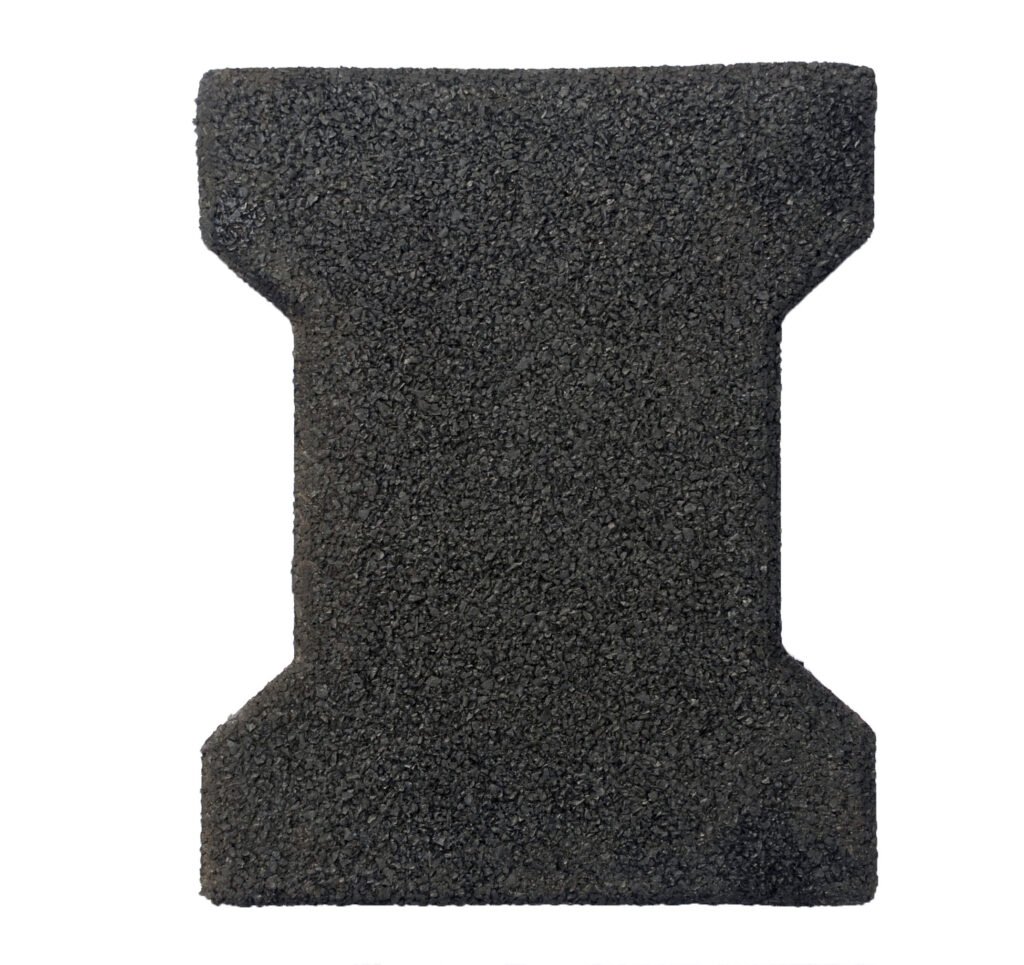
Can Horse Stall Mats Get Wet?
The horse stall mat, often made of durable rubber, plays an integral role in ensuring the comfort and health of your horse. However, a common concern many barn owners and equestrians face is: what happens when these mats get wet? Let’s dive into the properties of these mats and discuss how to handle wet spots effectively.
Understanding Rubber Stall Mat Properties
1. Durability: Horse stall mats, primarily made from rubber, are designed to be sturdy and durable. They can withstand the weight of a horse, resist wear and tear, and, yes, handle moisture to a certain degree.
2. Non-absorbent Nature: Rubber is inherently non-absorbent. This means while water or urine won’t seep into the mat, they can get trapped underneath or pool on the surface if not addressed, potentially creating an unsanitary environment.
3. Traction and Safety: A wet rubber mat can become slippery, posing a safety risk for both the horse and anyone working in the stall. Therefore, ensuring the mat remains dry prevents slips and falls.
Dealing with Wet Spots and Proper Drying Methods
1. Immediate Action: If you notice a wet spot, it’s crucial to address it promptly. Using a squeegee or a sponge mop can help push out and soak up the excess moisture from the mat surface.
2. Lifting and Drying: In case of significant moisture, especially underneath the mat, lift the mat and allow the stall floor and the mat to air dry. Proper ventilation in the stall speeds up the drying process.
3. Absorbent Materials: Consider using absorbent materials like sawdust or specific products designed for stall moisture absorption. They can be spread over the wet spot to soak up moisture and quickly remove.
4. Regular Checks: Regularly checking for wet spots during your regular stall cleaning can prevent prolonged moisture exposure. This practice ensures the longevity of your mat and maintains a healthy environment for your horse.
In summary, while rubber horse stall mats can handle moisture, it’s essential to ensure they don’t remain wet for extended periods. Implementing efficient drying methods and understanding the properties of rubber will provide a safer and cleaner stall environment for your beloved equine companions.

What Are the Best Practices for Cleaning a Horse Stall?
Cleaning a horse stall is more than just a chore; it’s a crucial step in ensuring your horse’s health, well-being, and comfort. The process might seem straightforward, but you can make the task more efficient with the proper techniques and tools. Here’s a detailed look into the best practices:
Essential Tools for Stall Cleaning
Before diving into the cleaning process, let’s equip ourselves with the right tools:
1. Manure Fork: This tool is specially designed to help you pick up and sift through bedding, making it easier to separate manure from clean shavings.
2. Sponge Mop: A good sponge mop is invaluable for cleaning wet spots and stains or deeper cleaning the stall floor.
3. Wheelbarrow: This aids in transporting manure, dirty bedding, and other waste out of the stall, making the disposal process smooth.
Step-by-Step Guide to Cleaning a Horse Stall
1. Remove the Horse: Always ensure your horse is safely secured outside the stall before you begin cleaning.
2. Start with Manure: Remove all the visible manure using the manure fork. Be meticulous; it’s easy to miss small bits. Transfer the waste to your wheelbarrow for disposal.
3. Identify Wet Spots: Wet spots, often darker than the surrounding bedding, are usually where the horse has urinated. Dig out the wet bedding down to the stall floor using the fork.
4. Scrub if Necessary: For persistent wet spots or stains, use the sponge mop dampened with a mixture of water and a mild cleaning solution. Scrub the area and then allow it to dry.
5. Remove Old Bedding: Depending on your cleaning schedule, occasionally remove all the bedding to do a comprehensive clean. This ensures any hidden moisture or soiled bedding doesn’t compromise the stall environment.
6. Disinfect the Stall Floor: Every so often, after removing all bedding, use a mild disinfectant to clean the stall floor. This step reduces the risk of bacterial growth and keeps the environment sanitary.
7. Add Fresh Shavings: Add a layer of fresh shavings once the stall is clean and dry. Spread them evenly across the stall floor, ensuring you add enough to provide comfort but not so much that it becomes wasteful.
8. Return the Horse: Once the stall is clean, dry, and freshly bedded, it’s safe to return your horse to its clean and comfortable environment.
By following these best practices, you will ensure a cleaner environment for your horse, prolong the life of your stall mats, and make daily maintenance more manageable. Remember, a clean stall is key to a happy and healthy horse!
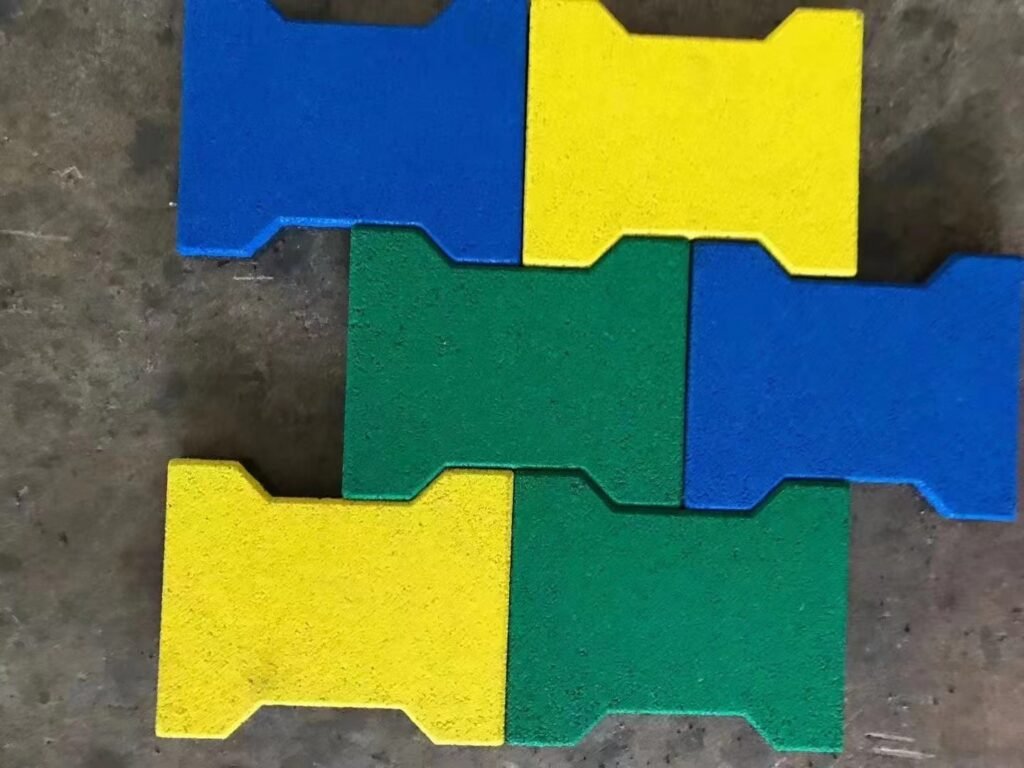
How Long Does Cleaning a Horse Stall Typically Take?
Cleaning a horse stall is a ritualistic task for many horse owners, and the time it takes can vary widely based on several factors. However, with the right strategies and tools, you can optimize your routine and get it done efficiently.
Factors Affecting Cleaning Time
1. Size of the Stall: Larger stalls take more time to clean than smaller ones.
2. Frequency of Cleaning: If you clean the stall daily, the process becomes quicker and easier than cleaning a booth left for several days.
3. Horse Habits: Some horses are messier than others. A horse that frequently urinates or defecates in the stall or moves around a lot can create more work.
4. Bedding Type: Certain types of bedding are more accessible to sift through and clean than others.
Tips for Efficient and Fast Cleaning
1. Use the Right Tools: A sturdy manure fork, a reliable wheelbarrow, and other essential tools can significantly speed up the process.
2. Develop a System: Establish a routine. Start from one end of the stall and work methodically to the other. Over time, this systematic approach becomes second nature, and you’ll find yourself working faster.
3. Stay Consistent: Cleaning the stall simultaneously daily can make the task less cumbersome and more routine.
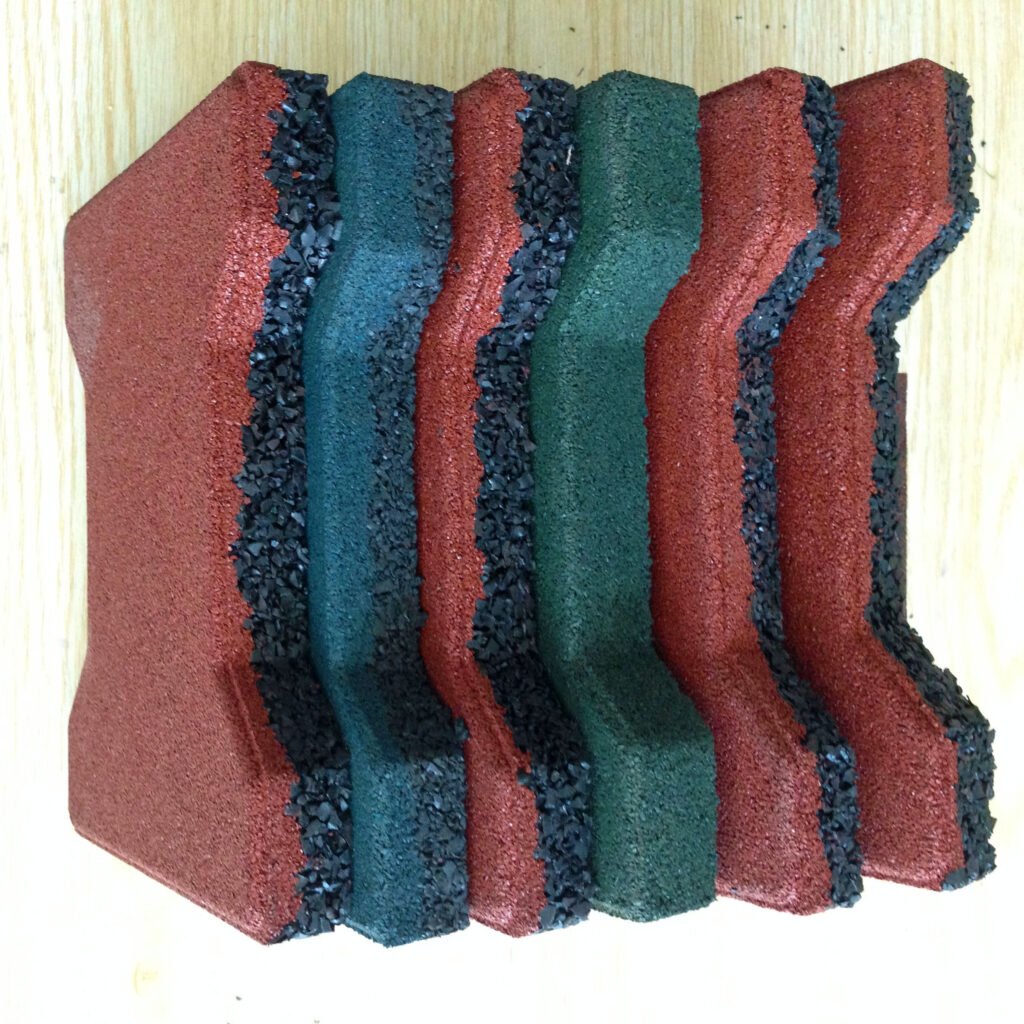
How Do You Handle Stall Cleaning in Wet Conditions?
Wet conditions pose a unique challenge when cleaning horse stalls. The presence of moisture can lead to mold growth and other health risks for the horse. Therefore, dealing with wet conditions promptly and efficiently is essential.
Dealing with Wet Bedding and its Importance
1. Identification: Wet bedding, often darker than its dry counterpart, needs to be removed as soon as it’s spotted. It’s not just about cleanliness – wet bedding can become a breeding ground for bacteria and mold.
2. Immediate Removal: Dig out the wet bedding down to the stall floor using a manure fork. Removing as much of it as possible prevents moisture from getting trapped underneath.
Ensuring the Stall Floor is Completely Dry
1. Aerate the Stall: Once the wet bedding is removed, allowing the damp spot on the stall floor to air out is crucial. This can be facilitated by raking the dry bedding away from the wet area and letting it air dry.
2. Use Absorbent Materials: Spread absorbent materials, such as sawdust or specialized products, over the wet area. They’ll soak up excess moisture and can be removed once they’ve done their job.
3. Check for Drainage Issues: If your stall frequently has wet conditions, there might be underlying drainage problems. Addressing these can prevent recurrent issues and reduce the frequency of deep cleaning.
4. Disinfect if Needed: Consider using a mild disinfectant to prevent bacterial and mold growth in persistently wet conditions.
Handling stall cleaning during wet conditions might take extra effort, but it’s crucial for the health and comfort of your horse. You can maintain a safe and hygienic environment in the stall by acting promptly and ensuring complete drying.

Maintaining a clean and hygienic horse stall is more than just a daily chore; it’s a commitment to the health and well-being of your equine companion. From understanding the intricacies of cleaning horse stall mats to ensuring dryness in wet conditions, each aspect plays a pivotal role in fostering a safe environment. By equipping oneself with the proper knowledge, tools, and a consistent routine, stall cleaning becomes manageable and a reflection of the care and dedication one has for one’s horse. Always remember, a clean stall leads to a happier, healthier horse.


